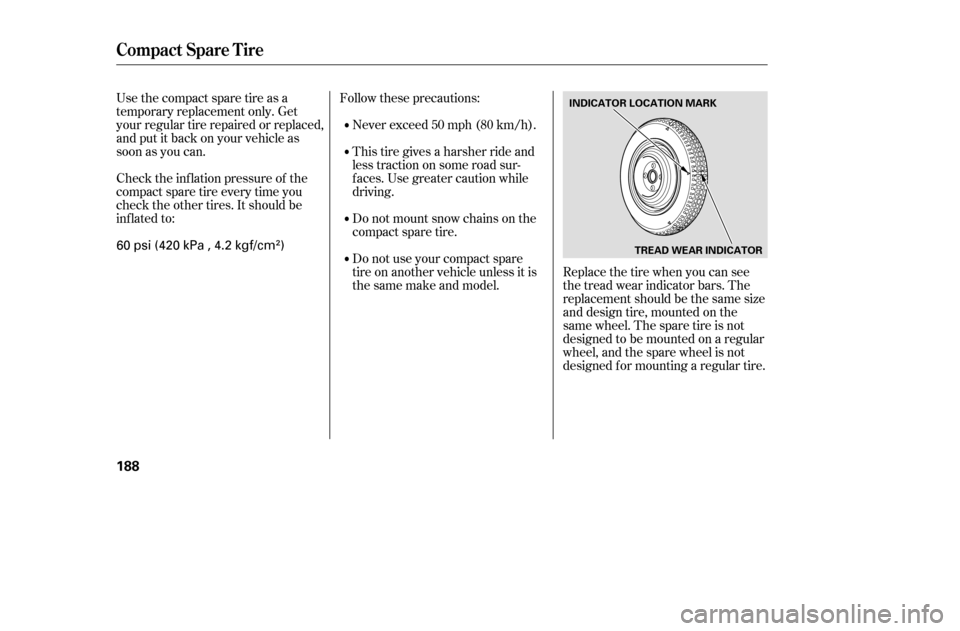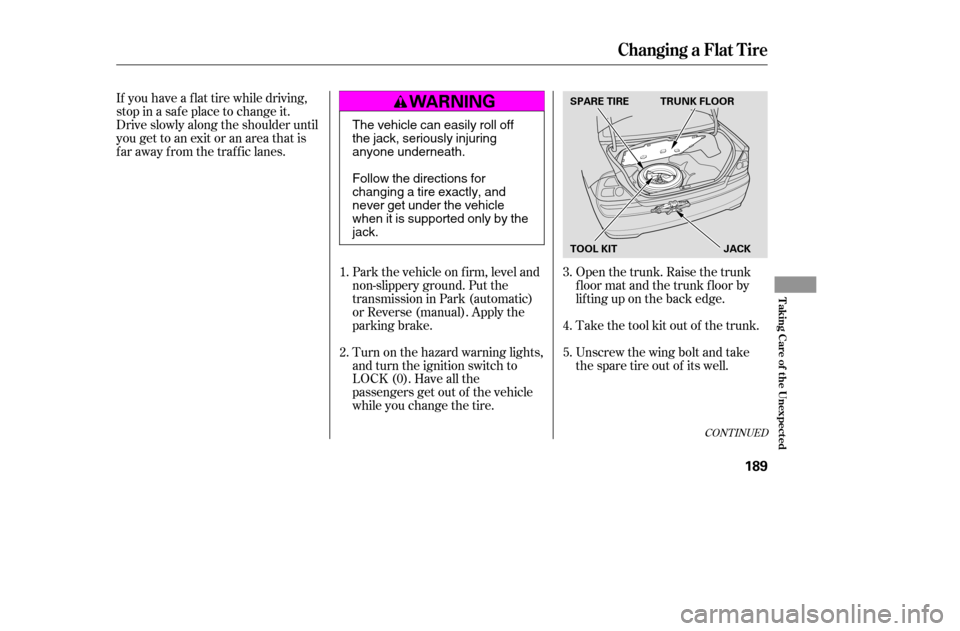Page 170 of 226

Keeping the tires properly inf lated
provides the best combination of
handling, tread lif e, and riding
comf ort.Underinf lated tires wear unevenly,
adversely affect handling and fuel
economy, and are more likely to
fail from being overheated.
Overinf lated tires can make your
vehicleridemoreharshly,are
more prone to damage f rom road
hazards, and wear unevenly.
We recommend that you visually
check your tires every day. If you
think a tire might be low, check it
immediately with a tire gauge.
The f ollowing pages give more
detailed inf ormation on how to take
care of your tires and what to do
when they need to be replaced.
To saf ely operate your vehicle, your
tires must be the proper type and
size, in good condition with adequate
tread, and correctly inf lated.
Use a gauge to measure the air
pressure in each tire at least once a
month. Even tires that are in good
condition may lose one to two psi (10
to 20 kPa, 0.1 to 0.2 kgf /cm ) per
month. Remember to check the
sparetireatthesametime.
Check the air pressures when the
tires are cold. This means the
vehicle has been parked f or at least
three hours, or driven less than 1
mile (1.6 km). Add or release air, if
needed, to match the recommended
cold tire pressures on page .
179
Tires
Inf lation Guidelines
178
Using tires that are excessively
worn or improperly inflated can
cause a crash in which you can
be seriously hurt or killed.
Follow all instructions in this
owner’s manual regarding tire
inflation and maintenance.
�����—�����—�����y�
������
������y���
�(���%�������y���
���
�y
Page 171 of 226

While tubeless tires have some
ability to self -seal if they are
punctured, you should look closely
for punctures if a tire starts losing
pressure.
Youshoulduseyourowntire
pressure gauge whenever you check
your tire pressures. This will make it
easier f or you to tell if a pressure
loss is due to a tire problem and not
due to a variation between gauges.
If you check air pressures when the
tires are hot [driven f or several miles
(kilometers)], you will see readings 4
to6psi(30to40kPa,0.3to0.4
kgf /cm ) higher than the cold
readings.Thisisnormal.Donotlet
air out to match the recommended
cold air pressure. The tire will be
underinf lated.
The following charts show the
recommended cold tire pressures f or
most normal driving conditions and
speeds.
Honda strongly recommends that
you not drive f aster than posted
speed limits and conditions allow. If
you decide it is safe to drive at high
speeds (over 100 mph or 160 km/h),
be sure to adjust the cold tire
pressuresasshownbelow.If youdo
not, excessive heat can build up and
cause sudden tire f ailure.
Thecompactsparetirepressureis:
Tire Size
Cold Tire Pressure
f or High-Speed
Driving
Tire Size Cold Tire Pressure for Normal Driving
Tire Size Cold Tire Pressure
for Normal Driving
Tire Size Cold Tire Pressure
for Normal Driving
CONT INUED
U.S.: DX, Value Package, HX, Canada: DX
Canada: LX
U.S.: DX, Value Package, HX, Canada: DX
U.S. DX, Value Package, HX and
Canadian DX models only
U.S.: LX, EX, Special Edition, Canada: Si, REVERB
Tires
Recommended Tire Pressures
Normal Driving
High-Speed Driving
Maint enance
179
60 psi (420 kPa , 4.2 kgf/cm)
P185/70R14 87S 35 psi (240 kPa , 2.4kgf/cm
)
P195/60R15 87H 30 psi (210 kPa , 2.1 kgf/cm
)
P185/65R15 86H 30 psi (210 kPa , 2.1
kgf/cm
)
P185/70R14 87S 30 psi (210 kPa , 2.1
kgf/cm
)
�����—�����—�����y�
������
������y���
�(���%�������y���
�����y
Page 179 of 226

Use the compact spare tire as a
temporary replacement only. Get
your regular tire repaired or replaced,
and put it back on your vehicle as
soon as you can.
Check the inf lation pressure of the
compact spare tire every time you
check the other tires. It should be
inf lated to:Replace the tire when you can see
the tread wear indicator bars. The
replacement should be the same size
and design tire, mounted on the
same wheel. The spare tire is not
designed to be mounted on a regular
wheel, and the spare wheel is not
designed f or mounting a regular tire.
Follow these precautions:
Never exceed 50 mph (80 km/h).
This tire gives a harsher ride and
less traction on some road sur-
f aces. Use greater caution while
driving.
Do not mount snow chains on the
compact spare tire.
Do not use your compact spare
tire on another vehicle unless it is
thesamemakeandmodel.
Compact Spare Tire
188
INDICATOR LOCATION MARK
TREAD WEAR INDICATOR
60 psi (420 kPa , 4.2 kgf/cm)
�����—�����—�����y�
�������������y���
�(���%�������y���
���
�y
Page 180 of 226

Park the vehicle on f irm, level and
non-slippery ground. Put the
transmission in Park (automatic)
or Reverse (manual). Apply the
parking brake.
Turn on the hazard warning lights,
and turn the ignition switch to
LOCK (0). Have all the
passengers get out of the vehicle
while you change the tire.Take the tool kit out of the trunk.
Unscrew the wing bolt and take
the spare tire out of its well.
Open the trunk. Raise the trunk
f loor mat and the trunk f loor by
lif ting up on the back edge.
If you have a f lat tire while driving,
stop in a saf e place to change it.
Drive slowly along the shoulder until
you get to an exit or an area that is
far away from the traffic lanes.
5.
4.
3.
2.
1.
CONT INUED
Changing a Flat T ire
T aking Care of t he Unexpect ed
189
SPARE TIRE TRUNK FLOOR
TOOL KIT JACK
The vehicle can easily roll off
the jack, seriously injuring
anyone underneath.
Follow the directions for
changing a tire exactly, and
never get under the vehicle
when it is supported only by thejack.
�����—�����—�����y�
�������������y���
�(���%�������y���
�����y
Page 182 of 226
CONT INUED
Use the extension and the wheel
nut wrench as shown to raise the
vehicle until the f lat tire is of f the
ground.Do not attempt to forcibly pry the
wheel cover of f with a screwdriver
or other tool. The wheel cover
cannot be removed without f irst
removing the wheel nuts.
Remove the wheel nuts, then
remove the f lat tire. Handle the
wheel nuts caref ully; they may be
hot f rom driving. Place the f lat tire
on the ground with the outside
surface facing up. Bef ore mounting the spare tire,
wipe any dirt of f the mounting
surface of the wheel and hub with
a clean cloth. Wipe the hub
carefully;itmaybehotfrom
driving.
9.
11.
10.DX, Value Package, and LX models
Changing a Flat T ire
T aking Care of t he Unexpect ed
191
EXTENSION WHEEL
NUTS
WHEEL NUTS WHEEL COVER
WHEEL NUT WRENCH BRAKE HUB
�����—�����—�����y�
�������������y���
�(���%�������y���
�����y
Page 183 of 226
Put on the spare tire. Put the
wheel nuts back on f inger-tight,
then tighten them in a crisscross
pattern with the wheel nut wrench
until the wheel is f irmly against
the hub. Do not try to tighten
them f ully.
Lower the vehicle to the ground
and remove the jack.Remove the center cap from the
flat tire.
Tighten the wheel nuts securely in
the same crisscross pattern. Have
the wheel nut torque checked at
the nearest automotive service
f acility.
Tighten the wheel nuts to:
12.
13. 14.
15.On HX, Special Edition, and EX
models in the U.S., REVERB and Si
models in Canada
Changing a Flat T ire
192
80 lbf·ft (108 N·m , 11 kgf·m)
�����—�����—�����y�
�������������y���
�(���%�������y���
�����y
Page 184 of 226
Place the flat tire face down in the
spare tire well.
Remove the spacer cone f rom the
wing bolt, turn it over, and put it
back on the bolt.
Securetheflattirebyscrewing
the wing bolt back into its hole.Store the jack in the trunk with the
end bracket on the lef t side. Turn
the jack’s end bracket to lock it in
place. Store the tool kit.
Store the wheel cover or center
cap in the trunk. Make sure it does
not get scratched or damaged.
Lower the trunk f loor, then close
the trunk lid.
16.
17.
18. 19.
20. 21.
Changing a Flat T ire
T aking Care of t he Unexpect ed
193
WING BOLT SPACER CONE
Loose items can fly around the
interiorinacrashandcould
seriously injure the occupants.
Store the wheel, jack, and tools
securely before driving.
�����—�����—�����y�
�������������y���
�(���%�������y���
�����y
Page 205 of 226

�µ�µ�µ
�µ�µ
�Î �Î�Î�Î �Î
�µ �µ�µ �µ �µ�µ�µ�µ�µ�µ�µ�µ�µ �µ �µ
�Î �Î
�Î
�Î �Î �Î�Î�Î
�Î�Î
Specif ications
T echnical Inf ormation
215
Air Conditioning Fuses
Alignment
Tires
Lights Battery HFC-134a (R-134a)
17.6 19.4 oz (500 550 g)
12 V
12 V 60 W
2°14’45’
0°
0.00 in (0.0 mm)
P185/65R15 86H P185/70R14 87S
0.08 in ( 2.0 mm)
12 V
51 W
60 psi (420 kPa , 4.2 kgf/cm
)
30 psi (210 kPa , 2.1 kgf/cm)
T125/70D15 95M
T115/70D14 88M
P195/60R15 87H
Refrigerant type
Charge quantity
Lubricant oil type
Interior
Under-hood
Toe-in
CamberCaster Size
Pressure
24/2.2 CP
See page 208 or the fuse label
attached to the inside of the fuse
box door under the steering
column.
See page 207 or the fuse box
cover.
Headlights (HI)
Headlights (LO)
Front turn signal/Side marker/
Parking light
Rear turn signal lights
Stop/Taillights
Back-up lights
High-mount stop light
License plate lights
Ceiling light
Front ceiling light
Spotlights
Trunk light SP-10
12 V 5 W 8W
12 V
12 V 5 W 5W
12 V 10 W
12 V 3CP
12 V 21 W
12 V 18 W
12 V 21/5 W
12 V 21 W
12 V
Capacity 12 V
12 V
38 AH/5 HR
36 AH/5 HR Front Rear
FrontRear
Front
3:4:5:6: 7:
(HB3)
Front/Rear
Spare
Front/Rear
Spare
(HB4)
U.S.: DX, Value Package, HX Canada: DX
Canada: LX
U.S.: LX, EX, Special Edition Canada: Si, REVERB
1 : U.S.: EX, EX Special Edition
Canada : Si
2 : LX, LX Special Edition
U.S.: DX, Value Package, HX, LX and LX Special Edition
Canada : DX, LX, REVERB
U.S.: LX with ABS, EX, Special Edition
Canada: LX with ABS, Si
112 345
67
�����—�����—�����y�
�������������y���
�(���%�������y�����
���y